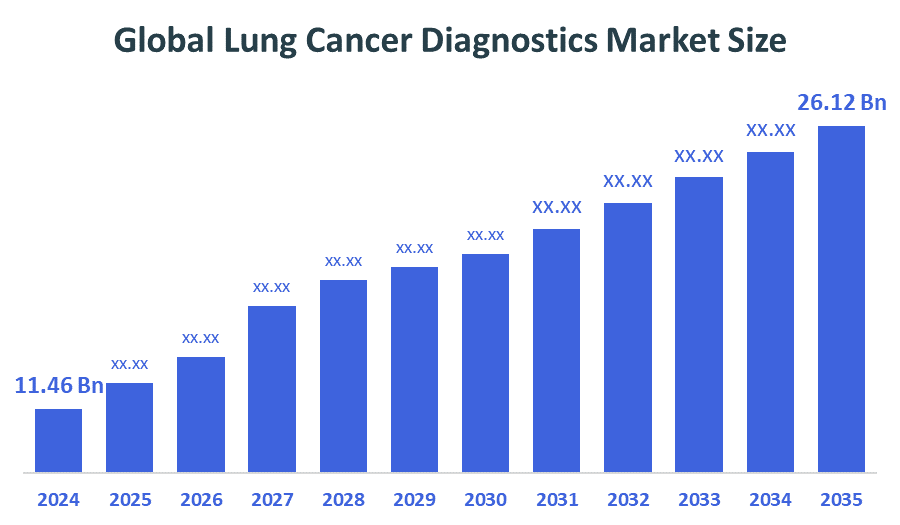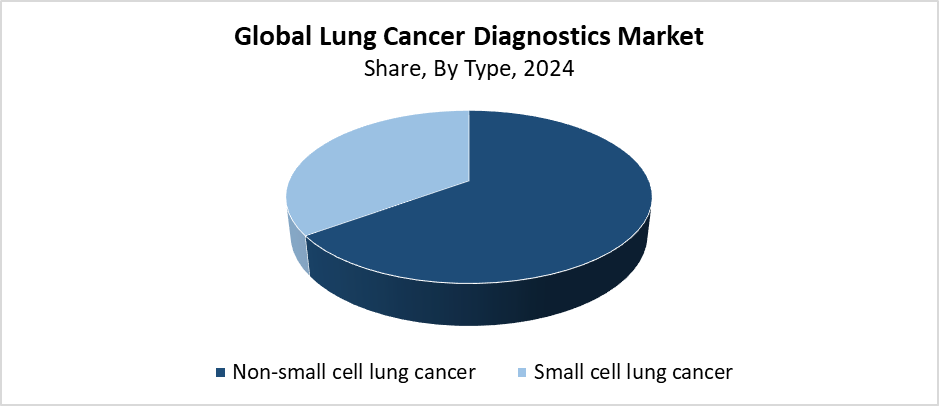Global Lung Cancer Diagnostics Market
Global Lung Cancer Diagnostics Market Size, Share, and COVID-19 Impact Analysis, By Type (Small Cell Lung Cancer, Non-Small Cell Lung Cancer), By Test (CA test, HER2 test, ALK test, Angiogenesis Inhibitors, EGFR Mutation test, KRAS Mutation test), and By Region (North America, Europe, Asia-Pacific, Latin America, Middle East, and Africa), Analysis and Forecast 2025 - 2035
Report Overview
Table of Contents
Lung Cancer Diagnostics Market Summary
The Global Lung Cancer Diagnostics Market Size Was Estimated at USD 11.46 Billion in 2024 and is Projected to Reach USD 26.12 Billion by 2035, Growing at a CAGR of 7.78% from 2025 to 2035. The market for lung cancer diagnostics is expanding as a result of aging populations, growing awareness of early detection, rising lung cancer prevalence, improvements in diagnostic technology, and encouraging government programs like screening programs and research funding meant to enhance early diagnosis and treatment results.

Key Regional and Segment-Wise Insights
- In 2024, North America held the greatest revenue share of 39.42% in the worldwide lung cancer diagnostics market.
- With the biggest revenue share of 65.3% in 2024, the non-small cell lung cancer (NSCLC) segment led the global market by type.
- In 2024, the EGFR mutation tests segment had the highest revenue share, accounting for 37.5% based on the test.
Global Market Forecast and Revenue Outlook
- 2024 Market Size: USD 11.46 Billion
- 2035 Projected Market Size: USD 26.12 Billion
- CAGR (2025-2035): 7.78 %
- North America: Largest market in 2024
The market dedicated to tools and diagnostic testing methods for lung cancer detection across various stages operates under the lung cancer diagnostics market. The market includes molecular diagnostics alongside biopsy procedures, as well as biomarkers and imaging techniques, including CT scans and X-rays. Market growth stems from the rising global incidence of lung cancer, mainly because of increasing tobacco consumption along with deteriorating air quality and work-related health hazards. Modern medical practice requires precise, minimally invasive diagnostic methods to improve patient results because early diagnosis proves essential for better patient outcomes. Market expansion results from demographic changes in aging populations and improved healthcare development in developing nations, and increased public awareness about cancer screening.
The field of lung cancer diagnosis experiences a revolutionary transformation through liquid biopsy, together with next-generation sequencing and AI-powered imaging techniques, which enhance both precision and early detection effectiveness. These techniques enable precise tumor profiling, which leads to customized treatment approaches. Lung cancer receives worldwide government support through national screening initiatives, together with research investments and public health educational programs. Various nations have implemented low-dose CT screening programs for high-risk populations, which leads to more early-stage diagnoses and boosts funding for advanced diagnostic technologies.
Type Insights

The non-small cell lung cancer (NSCLC) segment accounted for the largest revenue share of 65.3% and led the lung cancer diagnostics market in 2024. The diagnosis of most lung cancer cases across the globe consists of NSCLC, which stands as the most prevalent disease subtype. Advanced diagnostic equipment and technology systems meant for NSCLC diagnosis and monitoring find their market demand because of rising incidence rates. The sector's position strengthened because of advances in imaging methods, together with biomarker analysis and molecular diagnostic testing. The growth of NSCLC diagnostic methods gained support from better patient education programs as well as new screening protocols and personalized medicine breakthroughs. The NSCLC segment continues to shape the development of lung cancer diagnostics despite its substantial influence on the overall market.
The Small-cell lung cancer (SCLC) segment of the lung cancer diagnostics market is anticipated to grow at a significant CAGR throughout the forecast period. Small cell lung cancer (SCLC) comprises fewer lung cancer cases than non-small cell lung cancer (NSCLC), but its rapid progression and aggressive nature demand timely and accurate diagnosis. The market expands because of improved diagnostic imaging techniques and new biomarker discoveries, as well as growing awareness about small-cell lung cancer. Research progression and targeted drug development have driven increased demand for precise SCLC diagnostic methods. The SCLC market segment will experience accelerated expansion during the upcoming years.
Test Insights
The EGFR mutation tests segment held the highest revenue share of 37.5% during 2024 and led the lung cancer diagnostics market. The diagnosis and treatment of lung cancer, including non-small cell lung cancer (NSCLC), requires EGFR mutation testing because it identifies exact genetic abnormalities that need personalized medication. The expanding application of precision medicine, together with specific therapy choices, drives the rising demand for EGFR mutation testing. The accuracy and speed of these tests have advanced because of molecular diagnostic technology improvements, such as liquid biopsy and next-generation sequencing (NGS), which have led to their increased market share. The EGFR mutation test segment continues to grow because both healthcare practitioners and patients recognize the importance of genetic profiling in lung cancer treatment.
During the forecast period, the HER2 test segment of the lung cancer diagnostics market is anticipated to grow at a significant CAGR. The rapid expansion of HER2 testing occurs because scientists better understand how the HER2 gene functions in lung cancer and its use in treatment selection. The rising demand for accurate HER2 testing stems from diagnostic technique advancements, together with newly developed HER2-targeted drugs. The ongoing clinical studies on HER2 as a lung cancer therapeutic target, together with the related research, contribute to market expansion. Personalized treatment developments will lead to substantial growth of the HER2 test segment within the lung cancer diagnostics market.
Regional Insights
In 2024, North America held the largest revenue share of 39.42% and led the lung cancer diagnostics market. Healthcare excellence, combined with the quick adoption of advanced diagnostic technology in this region, stands as the primary reason behind its market leadership. The market expansion received a substantial boost because patients and healthcare practitioners became more aware of lung cancer, while government programs supported lung cancer screening initiatives. The large research and development funding in North America enables the easy introduction of advanced diagnostic instruments. The market growth depends heavily on North America's reimbursement system, along with its substantial industry presence. The lung cancer diagnostics market will maintain its North American leadership position because early detection and personalized treatment methods will receive increasing attention throughout the next years.
Europe Lung Cancer Diagnostics Market Trends
In 2024, Europe held a significant revenue share of the lung cancer diagnostics market because the region prioritizes healthcare advancement and cancer detection initiatives. Market growth occurs primarily through the established healthcare systems, together with the rising adoption of modern diagnostic technology. Early lung cancer screening, together with awareness-raising initiatives backed by government programs, has driven increased market demand. The market share of Europe grew due to its extensive research and development activities focused on personalized medicine and molecular diagnostics approaches. The development of lung cancer diagnostics in Europe receives additional backing from major industry players and favorable reimbursement structures. The worldwide lung cancer diagnostics business identifies Europe as a key market because of the combined characteristics present in this region.
Asia Pacific Lung Cancer Diagnostics Market Trends
The Asia Pacific lung cancer diagnostics market will experience the fastest growth during the forecast period. Rapid lung cancer incidence and growing awareness about early detection methods, along with treatment choices, serve as primary factors driving this fast expansion in the region. The market grows because healthcare infrastructure develops, and more investment goes toward modern diagnostic technology. Government programs, along with screening initiatives that work to reduce lung cancer death rates, continue to boost diagnostic demand. The expanding population base, along with rising medical expenses in the region, drives this market growth. Industry leaders entering the market through strategic partnerships to deliver advanced diagnostic solutions will push the Asia Pacific lung cancer diagnostics market to grow at an accelerated pace during the forecast period.
Key Lung Cancer Diagnostics Companies:
The following are the leading companies in the lung cancer diagnostics market. These companies collectively hold the largest market share and dictate industry trends.
- F. Hoffmann-La Roche Ltd
- bioMérieux
- Abbott
- Thermo Fisher Scientific
- Bio-Rad
- Agilent Technologies
- Qiagen
- Neogenomics Laboratories
- Illumina Inc.
- Myriad Genetics, Inc.
- Others
Recent Developments
- In June 2025, Taletrectinib (Ibtrozi) was approved by the US FDA to treat non-small cell lung cancer (NSCLC) that is ROS1-positive. In addition to guaranteeing the prompt identification of individuals qualified for targeted therapy, this approval highlights the growing significance of ROS1 fusion testing as a component of complete biomarker diagnostics and strengthens the role of molecular diagnostics in directing individualized lung cancer treatment.
- In February 2025, Imagene and Tempus established a partnership to develop AI-powered non-small cell lung cancer (NSCLC) diagnoses. The collaboration aims to create an AI-based multi-gene panel that can quickly and accurately identify important NSCLC biomarkers from biopsy pictures, including EGFR, ALK, and MET. This effort aims to speed up biomarker profiling and optimize lung cancer diagnostic workflows by utilizing Tempus' vast real-world clinical dataset to improve the accuracy of Imagene's AI models.
Market Segment
This study forecasts revenue at global, regional, and country levels from 2020 to 2035. Decision Advisor has segmented the lung cancer diagnostics market based on the below-mentioned segments:
Global Lung Cancer Diagnostics Market, By Type
- Non-small cell lung cancer
- Small cell lung cancer
Global Lung Cancer Diagnostics Market, By Test
- CA test
- HER2 test
- ALK test
- Angiogenesis Inhibitors
- EGFR Mutation test
- KRAS Mutation test
Global Lung Cancer Diagnostics Market, By Regional Analysis
- North America
- US
- Canada
- Mexico
- Europe
- Germany
- UK
- France
- Italy
- Spain
- Russia
- Rest of Europe
- Asia Pacific
- China
- Japan
- India
- South Korea
- Australia
- Rest of Asia Pacific
- South America
- Brazil
- Argentina
- Rest of South America
- Middle East & Africa
- UAE
- Saudi Arabia
- Qatar
- South Africa
- Rest of the Middle East & Africa
Check Licence
Choose the plan that fits you best: Single User, Multi-User, or Enterprise solutions tailored for your needs.
We Have You Covered
- 24/7 Analyst Support
- Clients Across the Globe
- Tailored Insights
- Technology Tracking
- Competitive Intelligence
- Custom Research
- Syndicated Market Studies
- Market Overview
- Market Segmentation
- Growth Drivers
- Market Opportunities
- Regulatory Insights
- Innovation & Sustainability
Report Details
| Pages | 212 |
| Delivery | PDF & Excel via Email |
| Language | English |
| Release | Sep 2025 |
| Access | Download from this page |
